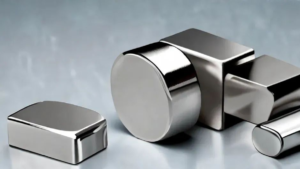

If you use small rare earth magnets in your industrial or business operations and want to know more about them, this guide is created for you.
From their unique properties to diverse applications across industries, we’ll delve into the fascinating world of small rare earth magnets.
Small rare earth magnets are powerful magnets made from special elements. Two of the small rare earth magnets are samarium and neodymium. Such magnets are very strong and used in many industries and everyday items. Even though they’re small, they’re very useful. They’re used in machines and household items. You can also use them for crafts and displays.
Small rare earth magnets come in various sizes, ranging from 1mm to 10mm. Each size serves different purposes based on its dimensions.
Extremely tiny, suitable for delicate applications such as crafting and jewelry making.
Slightly larger, but still ideal for intricate projects requiring a small but sturdy magnet.
Versatile size, commonly used in DIY projects, hobbies, and small-scale industrial applications.
Provides a balance between strength and size, suitable for various household and industrial uses.
Commonly used in electronics, sensor applications, and crafting projects requiring moderate strength.
Offers increased magnetic strength, suitable for heavier materials or slightly larger projects.
Provides stronger magnetic force, suitable for securing heavier objects or larger displays.
Ideal for industrial applications, machinery, and equipment requiring a robust magnet.
Offers even stronger magnetic force, suitable for demanding industrial and commercial purposes.
Largest among the small rare earth magnets, ideal for heavy-duty applications, machinery, and equipment.
Rare earth magnets, particularly neodymium magnets, provide the highest magnetic strength available. This makes them perfect for applications requiring strong magnetic fields in compact designs.
Although neodymium magnets are prone to corrosion, they can be coated with anti-corrosive materials. Samarium-cobalt magnets, on the other hand, show high corrosion resistance, making them useful in environments with chemical exposure and moisture.
Rare earth magnets can maintain their magnetic properties for extended periods, ensuring reliability in their applications.
Due to their structure, rare earth magnets generate strong magnetic fields even in small designs. This way, they maintain their magnetic performance while saving space and weight.
These magnets produce some of the strongest magnetic fields, enabling them to retain their magnetism when exposed to external magnetic fields and other demagnetizing factors.
The Curie temperature is the point at which a magnet loses its magnetic properties. Rare earth magnets, especially samarium-cobalt magnets, have high Curie temperatures. No wonder why they are considered for high-temperature environments such as motors and aerospace-based systems.
Rare earth magnets are comparatively expensive due to their rarity and complex mining and processing methods. Additionally, since only a few countries control their production, prices remain high and subject to control.
These magnets are prone to chipping or cracking when facing mechanical impacts or shocks. Machining them is challenging, requiring careful handling to prevent damage.
The strong magnetic force of rare earth magnets poses safety risks if mishandled. Their powerful attraction can cause injuries if body parts are caught between them.
Neodymium magnets have lower Curie temperatures compared to samarium cobalt magnets. This means they can lose their magnetic properties when exposed to higher temperatures beyond the Curie point.
Neodymium rare earth magnets contain iron, making them susceptible to corrosion. Without proper coating protection, they can deteriorate in humid or corrosive environments, affecting their performance and lifespan.
When choosing between similar products, ensure they meet performance expectations in the intended environment. Key factors to consider:
Consider coercivity, remanence, energy product, and Curie temperature. Neodymium magnets offer higher remanence and energy products, while samarium-cobalt magnets excel in Curie temperature and coercivity.
Choose between samarium-cobalt or neodymium magnets based on your needs. Neodymium magnets offer high magnetic strength, while samarium-cobalt magnets offer corrosion resistance and high-temperature stability.
Select a magnet shape and size that fits your application area. Options include disc, block, and cylinder magnets, which can also be customized.
Consider the cost, with neodymium magnets generally being more affordable than samarium-cobalt magnets due to manufacturing processes.
Choose magnets suitable for the operating temperature. Samarium-cobalt magnets are better for elevated temperatures due to higher Curie temperatures.
Consider how the magnet is magnetized—axially, diametrically, or through-thickness—based on application needs.
Calculate the minimum magnetic strength and field intensity needed for adequate performance, focusing on the magnet’s energy product.
Select magnets capable of tolerating environmental factors like moisture and chemicals. SmCo magnets or coated magnets are suitable for corrosive environments.
Rare earth magnets enhance performance and efficiency in electric motors and generators. Neodymium magnets in wind turbine generators convert kinetic energy into electrical energy efficiently.
Many automotive functions, including power steering and electronic systems, utilize magnetic components from rare earth elements. Neodymium magnets in electric vehicle motors ensure a high power-to-weight ratio for efficient propulsion.
Rare earth magnets are one of the key components being used in mobile phones, tablets, etc. Moreover, they are also used in high-definition loudspeakers and headphones.
Compact sensors benefit from rare earth magnets’ high magnetic strength. Proximity sensors, reed switches, and Hall-effect sensors are used in robotics and electronics applications.
Rare earth magnets are crucial components in compact medical devices like hearing aids. For example, they are used in MRI machines to generate strong magnetic fields for detailed images of the human body.
Due to their high-temperature stability, they are used in navigation instruments and missile guidance systems due to their reliability under extreme conditions.
Whether in electric motors, consumer electronics, or medical devices, these magnets play a crucial role in enhancing performance and efficiency. By understanding their properties, applications, and safety considerations, you can harness the full potential of small rare earth magnets in your projects and innovations.

Magnetic sheeting is a flexible material that can be magnetized on one side and often has an adhesive or printable surface on the other. It

Magnets come in various shapes and sizes, each designed for specific uses. Understanding the different shapes of magnets, their properties, and their applications can help

Magnets are a fascinating part of our everyday lives, from the magnets on our fridge doors to the powerful magnets used in advanced technology. There
Our magnet experts will help you get exactly what you need – custom or stock – in record time with great quality at a very competitive price.
Ⓒ 2024 - All Rights Are Reserved